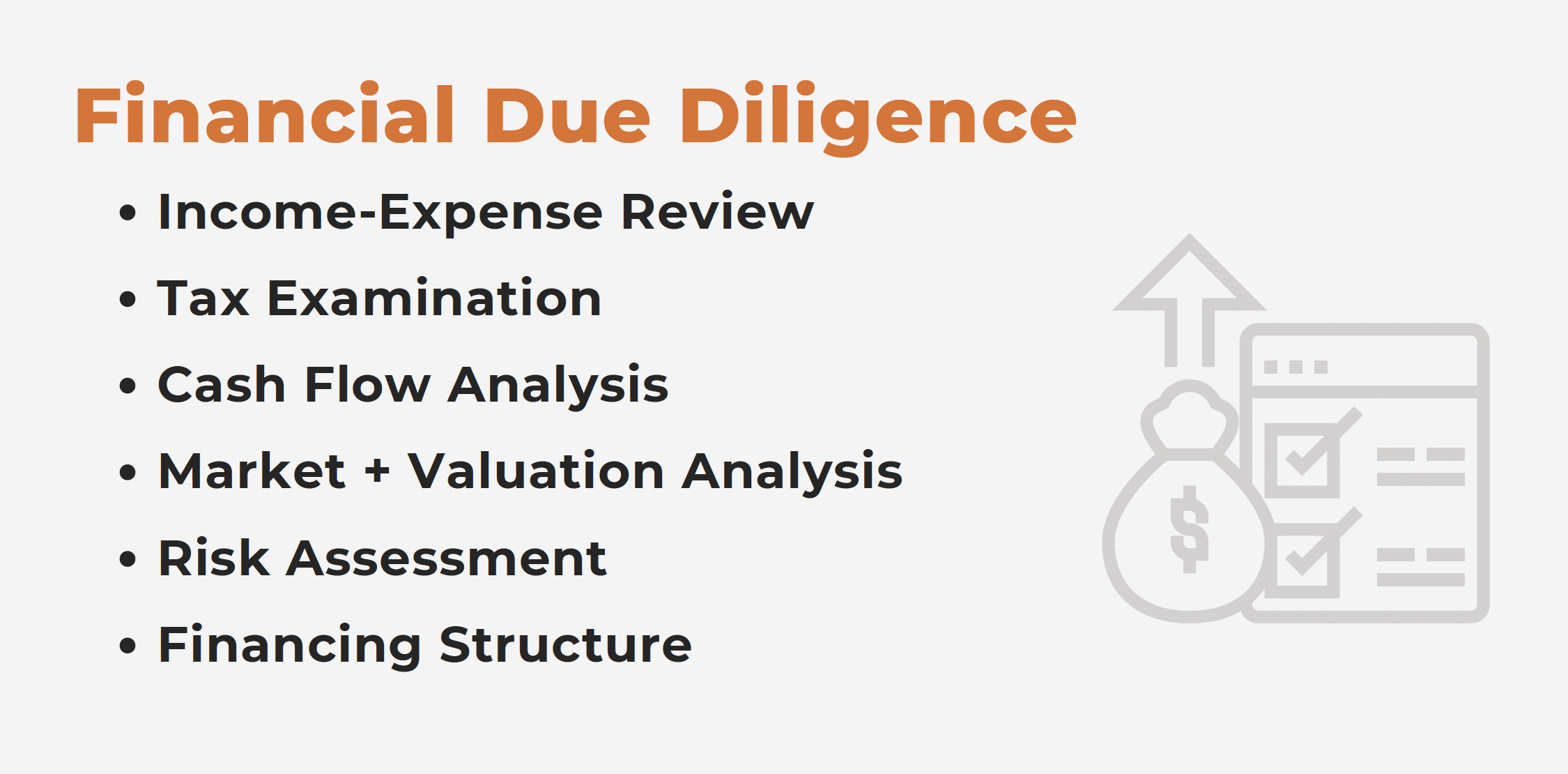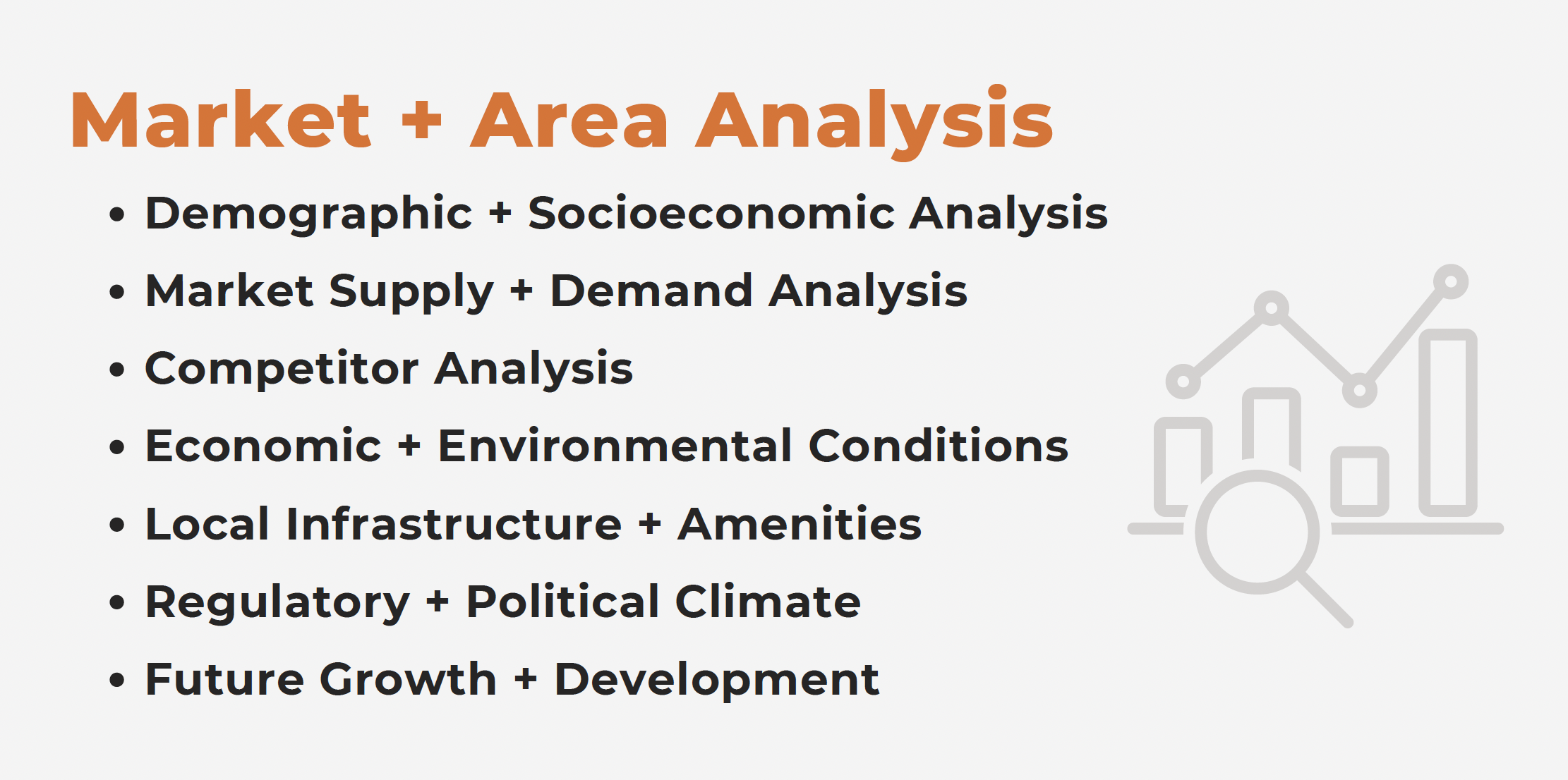Ensuring Investment Success: Comprehensive Due Diligence Strategies for Commercial Real Estate – Part 2
Welcome to Part 2 in our series on comprehensive due diligence strategies for commercial real estate. This post will cover financial due diligence and market and area analysis, two important elements of a thorough, meticulous due diligence strategy.
Financial Due Diligence
Financial analysis is a cornerstone of the due diligence process. It involves examining the economic viability and profitability of a property through detailed scrutiny of its income, expenses, and potential for future earnings. This thorough evaluation helps investors and stakeholders make informed decisions based on the financial health and projections of the property.
1. Income-Expense Review
Lease Analysis
- Rent Rolls: Review current rent rolls for information on rental rates, lease terms, renewals, and expirations.
- Lease Terms: Analyze key lease terms such as start and end dates, rent escalations, and tenant improvement allowances.
- Tenant Creditworthiness: Evaluate the financial stability of existing tenants to assess risk of default.
Operating Expenses
- Fixed Expenses: These include property taxes, insurance, and other non-variable costs.
- Variable Expenses: Costs such as utilities, management fees, maintenance, and janitorial that can fluctuate with the occupancy of the building.
- Capital Expenditures: Review historical and planned capital expenditures for building improvements and repairs.
Historical Financial Performance
Analyze past income statements and cash flow statements to identify financial trends and profitability.
2. Tax Examination
Property Tax Assessments
- Review current and historical property tax assessments to ensure they are accurate and reflect the property’s fair market value.
- Check for any outstanding property taxes or tax liens that could impact the transaction.
Tax Implications of Purchase
Understand the tax implications of purchasing and owning the property, including the potential for depreciation and other tax benefits.
3. Cash Flow Analysis
Net Operating Income (NOI)
Calculate NOI by subtracting total operating expenses from total income generated by the property. This metric helps assess the property’s profitability.
Cash Flow Projections
- Project future cash flows based on realistic occupancy rates, potential rent increases, and expected changes in operating expenses.
- Include scenarios for best, worst, and most likely financial outcomes to understand potential variability in returns.
Return on Investment (ROI)
Calculate expected ROI by comparing the cost of the investment against the returns expected from cash flows and the potential for appreciation.
4. Market and Valuation Analysis
Comparable Market Analysis (Comp Analysis)
Compare the subject property with similar properties in the area to estimate its market value based on achieved rents, sale prices, occupancy rates, and other relevant metrics.
Discounted Cash Flow (DCF) Analysis
Use DCF models to estimate the present value of expected future cash flows from the property. This analysis helps determine the viability of an investment over time.
5. Risk Assessment
Financial Risks
Identify potential financial risks such as tenant defaults, unexpected large expenses, or economic downturns affecting property values.
Sensitivity Analysis
Perform sensitivity analysis to understand how changes in key assumptions (e.g., occupancy rates, rent levels) impact the property’s financial outcomes.
6. Financing Structure
Loan Terms
Review terms of existing loans or potential financing options, including interest rates, amortization schedules, and loan-to-value ratios.
Debt Service Coverage Ratio (DSCR)
Calculate the DSCR to ensure that cash flow from the property will adequately cover debt payments.
Commercial real estate financial analysis is comprehensive and multifaceted. It provides essential insights into the profitability, risk, and valuation of properties to aid investors in making sound investment decisions. Given the complexity and stakes involved, it’s often advisable to involve financial analysts or advisors who specialize in real estate to ensure a thorough evaluation and interpretation of financial data.
Market and Area Analysis
Market and area analysis is a crucial part of the due diligence process. This analysis helps investors understand the local and broader economic conditions that could affect the property’s value, rental income potential, and long-term viability. Here’s a comprehensive look at what this process typically involves:
1. Demographic and Socioeconomic Analysis
Population Trends
Analyze population growth or decline in the area. Growing populations usually indicate potential for higher demand in residential and retail spaces.
Study age demographics to predict market demand trends (e.g., more senior housing needed in older populations).
Income Levels
Assess average income levels to gauge local residents’ spending power, which can influence the types of businesses that can thrive in the area.
Employment Rates
Review employment trends to understand the economic stability of the area. High employment rates typically bolster demand for office and retail spaces.
Socioeconomic Factors
Consider other factors such as education levels, economic diversification, and cultural aspects that might affect real estate demand.
2. Market Supply and Demand Analysis
Current Supply
Identify the existing supply of similar properties in the market (e.g., number of retail spaces, office buildings, warehouses) and analyze vacancy rates to understand if there is an oversupply or undersupply.
Future Supply
Look at planned or under-construction projects that could affect future supply and competition.
Demand Indicators
Assess current and projected demand for various types of properties based on business growth, residential needs, and other economic factors.
3. Competitor Analysis
Nearby Properties
Evaluate comparable properties in terms of size, quality, occupancy rates, and rental rates.
Determine competitive advantages or disadvantages of the subject property relative to others in the area.
Lease Terms
Compare lease structures, incentives offered, and tenant improvement allowances to understand competitive positioning.
4. Economic and Environmental Conditions
Economic Indicators
Look at local and national economic indicators like GDP growth, consumer spending, and business investment that could influence real estate markets.
Environmental Assessment
Consider environmental issues that might impact property use—like flood zones, earthquake risks, or other natural hazards.
5. Local Infrastructure and Amenities
Transportation Networks
Evaluate accessibility to major highways, public transit options, and other transportation facilities which can significantly impact property appeal.
Public Services
Review the quality and availability of public services such as schools, hospitals, police, and fire services as these can attract businesses and residents to the area.
Amenities
Check for nearby amenities like parks, malls, restaurants, and entertainment venues that enhance the attractiveness of the property.
6. Regulatory and Political Climate
Zoning Laws
Understand local zoning laws to assess any limitations or advantages for property use.
Government Stability and Policies
Consider the impact of local government stability, policies, and incentives on the real estate sector.
7. Future Growth and Development
Development Plans
Investigate any government or private sector development plans that could affect property values. Positive developments can boost property demand, while negative news might reduce it.
Economic Development Zones
Determine if the property is in an economic development zone, which might offer tax breaks or other incentives.
A Final Word On Market and Area Analysis
Conducting a thorough market and area analysis allows investors to make informed decisions by understanding the economic, demographic, competitive, and regulatory landscape of the area surrounding a commercial real estate investment. This analysis not only helps in assessing current conditions but also in forecasting future trends and potential market shifts. By integrating this analysis with financial and physical evaluations, investors can comprehensively understand their potential investment’s strengths and risks.
Next: Tenant and Lease Analysis, Environmental Assessments
Part 3 of our series on comprehensive due diligence strategies for commercial real estate, which you can read now, covers two more essential components of due diligence, tenant and lease analysis and environmental assessments.
In case you missed it, Part 1 covered property and building inspections and title and ownership verification.
Help With Your Commercial Real Estate Due Diligence Projects
If you buy or invest in commercial real estate and need help with your due diligence, Realogic has underwritten or conducted due diligence on over 10,000 properties over our 30+ years. Our skilled, experienced team can provide a wide range of due diligence services, including lease abstraction, financial diligence, financial model review, closing support, estoppels and more.
For more information, visit the due diligence page on our website or contact us at info@realogicinc.com or 312-782-7325.
About The Author
Mike Phelps is Realogic’s General Counsel. Mike has over 20 years of commercial real estate experience, including with financial modeling and analysis, analysis of acquisitions and dispositions, due diligence, underwriting, development and review of financial proformas and Argus/Dyna training. In his current role, he supports each of Realogic’s business lines and provides counsel on corporate, employment and compliance issues. He is also responsible for negotiation of contracts, master service agreements, software licenses and subscriptions and other intellectual property matters. Mike welcomes your comments on his post. He can be reached at mphelps@realogicinc.com

